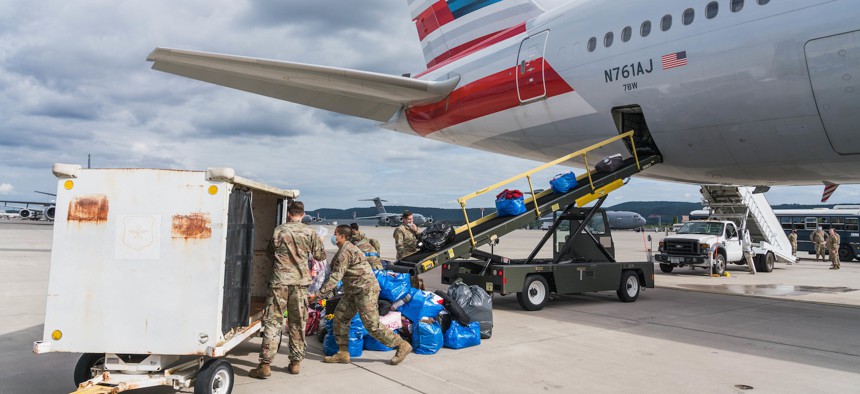
U.S. Air Force airmen assigned to the 721st Aerial Port Squadron load luggage onto an American Airlines aircraft during Operation Allies Refuge at Ramstein Air Base, Germany, Aug. 27, 2021. U.S. Air Force / Tech. Sgt. Donald Barnec
Commercial Planes, Ships Would Play Large Role in Pacific War, TRANSCOM Head Says
Last year’s massive Afghanistan evacuation could be a trial for how the military moves troops and equipment around the future battlefield.
Commercial airlines and shipping companies would be essential for moving troops and supplies around the battlefield if the United States is involved in a war in the Pacific, a top general said.
To facilitate that and other possible scenarios, U.S. officials are looking for ways to give companies more access to military intelligence and technologies that would allow them to fly and sail in areas where civilian networks and navigation satellites are blocked.
“The timing, tempo, and scale of potential future operations necessitates that we focus on building enduring advantages, especially our ability to command and control the global logistics formations and integrate them into the joint force,” Gen. Jacqueline Van Ovost, the head of U.S. Transportation Command, said during a call with reporters. “To do so, we must begin by treating data as a strategic asset.”
In recent decades, U.S. Transportation Command has often operated in the background, coordinating mass troop and supply movements in and out of conflict zones using a vast network of military and commercial aircraft, ships, and railroads. But over the past year, the command has gained international attention for its role in evacuating more than 120,000 people from Afghanistan, coordinating weapons deliveries to Ukraine, and even flying baby formula from Europe to the United States.
Since February, TRANSCOM aircraft have flown more than 820 missions to deliver weapons and equipment to Ukraine, Van Ovost said. Two thirds of those missions have been flown by contracted aircraft, not military aircraft or crews.
“For decades, our logistics prowess has masked operational risk,” Van Ovost said. “We must grow our capabilities to ensure that logistics does not cause premature culmination on the battlefield.”
Before Russia invaded Ukraine, TRANSCOM gave executives with security clearances a Ukraine intelligence briefing, sharing information about the security situation, Van Ovost siad. They also set up a process to share relevant intelligence information with the companies.
During a war in the Pacific, a vast region of dispersed military bases, the Pentagon would also rely heavily on commercial aircraft and ships, the general said.
During the August 2021 Afghanistan evacuation, TRANSCOM mobilized the Civil Reserve Air Fleet, a network of passenger and cargo airlines that make aircraft available for military missions. It was the third time in history the group had been activated. Large Air Force C-17 cargo planes flew evacuees to military bases throughout the Middle East. After being processed, the passengers were flown on the commercial planes to Europe and the United States.
“This is sort of a foreshadow for what I might see for use of the CRAF in the Pacific,” Van Ovost said.
The command is also looking at placing military advisors on merchant ships along with special communications gear that gives the ships a better picture of enemy locations. Military officials want to help ships “hide in plain sight” and remain on course if their GPS signal is jammed.
“We are doing these exercises with [commercial shipping companies] to do consolidated underway replenishment to place a tactical advisor, which is a Navy reservist, on board to advise the master on ship maneuvering, on emissions control, on secure communications, and understanding the battlespace, so that they can adequately maneuver into a more of a denied, degraded area to be effective into the future,” she said.
Military exercises will help determine requirements for new military cargo planes, Van Ovost said. The Air Force flies long-range C-5 and C-17 cargo planes and shorter, tactical C-130s to move troops and supplies. It can also use aerial tankers for logistics missions. The general said officials are looking at ways to better connect the planes and even equip them with electronic jamming to protect them.
“You may not need to have a kinetic capability to counter something on your airplane if you have something in the formation, whether it's kinetic or non kinetic, that can take care of that threat,” she said. “So it's so important to be part of that battle network.”




